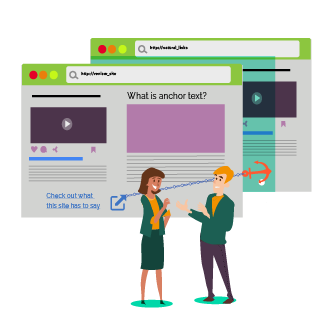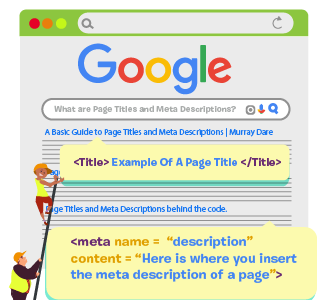When it comes to boosting your rankings on search engines, most marketers understand the importance of link building. However, what you probably don’t realise is that the words and phrases that connect to a link also have an important role to play in your website’s SEO.
These words are commonly known as anchor text. And search engines like Google pay more attention to them than you may have first realised.
Anchor text provides a great deal of context on the information within a link. But they also provide insight to search engines like Google. For instance, in regard to which websites are actively try to use it to their advantage to manipulate their search rankings.
Therefore, as you embark on your digital marketing strategy, it’s essential you understand the term. As well as how it impacts your website.
In this guide, we’ll learn all about anchor text, including the different types. And we’ll learn why you should use a diverse range. As doing so is critical for the success of your website’s SEO rankings.
What is Anchor Text?
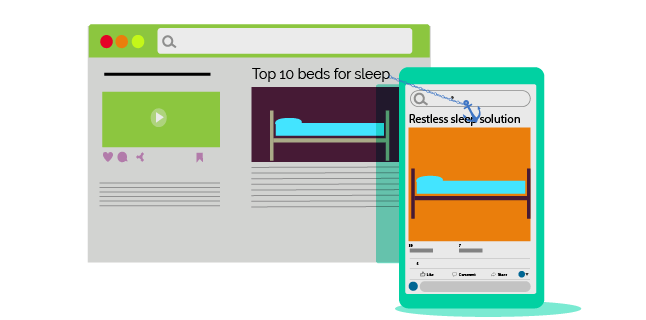
When a page links to another webpage, they usually do so by hyperlinking a relevant word or phrase. This visible, clickable, text is known as anchor text.
It is usually a different colour to the other text on the page and underlined. Therefore this indicates to readers that they can click on it, such as this link to my homepage.
But anchor text doesn’t only need to link web pages. For example, it can also link to documents like PDFs, or can initiate downloads.
When you browse the web, you probably don’t think about the impact that anchor text has on yourself. But as you begin to create content, you want to make sure that your anchor text is relevant. In fact, keep it as relevant to the link as possible. That way, your readers have an understanding of what the link is about; it will compel them to click on it.
But beyond this, your anchor text is also an important SEO signal. One that helps search engines find, categorise, rank, and return the most useful results to users’ search queries. Don’t worry, we’ll cover more of this in detail later.
Understanding Anchor Text As HTML
Whenever you create a piece of hyperlinked text, your webpage will store this as a piece of HTML code:
<a href=http://exampleofawebsitedomain.com>Example anchor text</a>
You can easily view the HTML code for anchor text of any website. Simply enter “Ctrl” and “U” on any Google Chrome browser. This will open up what is known as a pages ‘source code.’
When Google’s ‘bots’ then scan your webpage, they read this source code to interpret and understand your page of content.
As such, any words in the above code will count as your anchor text.
Why is Anchor Text Important for SEO?
In terms of your website’s SEO, anchor text can have an influence on your rankings in the search engines results pages (SERPs).
When an external website links to your site, Google will look at the anchor text they use for that link to understand what your page may be about. The more pages that link to you, the more understanding Google will have about your site. As links to your website, show Google how other websites (and people) view your page.

Over time, as you build your backlink profile, Google will collate all the keywords and search terms that link to you. They do this as a way to understand what your website is about. As well as, what keywords your site should rank for.
If you can obtain backlinks from a variety of high-quality websites that have a higher domain authority than you, then Google will trust these websites – because, let’s face it, why would a reputable website want to mislead their readers?
In this way, links from lots of high-quality sites to you for a given set of terms hints to Google that your content is valuable. That is, it is high-quality, relevant and definitely worth being seen. As a result, that particular webpage will start to rank well. Even if the terms don’t appear in the text itself.
Now, while you don’t have any control over what anchor text external sites use to link to you, Google still recommends that you: “make sure that anchor text you use within your own site is useful, descriptive, and relevant.” After all, if everyone implements good practices online, then everyone benefits from proper text attribution.
Be Careful About Overusing Anchor Text
Before you go full-steam ahead and start linking to anything and everything that’s relevant on your website. First take some time to understand the dangers that can come from the overuse of anchor text.
As we know, Google’s sole purpose is to deliver the best experience possible with their users. And to connect them to information that they think will best fulfil their search query.
If they suspect that a webpage is trying to put rankings above the quality of their content for the reader, they will penalise that webpage. For instance, if a webpage stuffs as many keywords in as possible into their anchor text.

Therefore, you must diversify the anchor text you use. The golden rule for anchor text is to keep it natural. Using exact keyword matches in your anchor text should be kept to a minimum. This will avoid search engines viewing it as a deliberate attempt of manipulation.
On top of this, you want to check that any links that come from external websites are from a variety of different anchor text roots. Though you may not have any control over these, they may make you consider whether you should use a nofollow tag to prevent Google from associating you with a heavy distribution of one or two keywords.
7 Types of Anchor Text
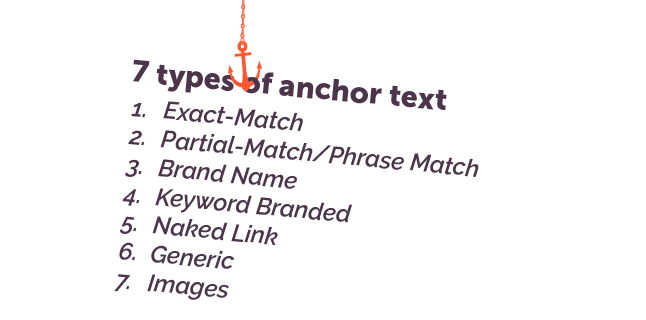
There are 7 main types of anchor text you can use on your web pages.
As we’ve established, make sure you’re using a combination of them and limit your number of exact match keywords. Otherwise you could find your web pages ranking lower as punishment by Google.
Familiarise yourself with the different types available. Then take a look at when and where you may want to use them within your content.
1. Exact-Match
Anchor text is an exact match if it includes a keyword that mirrors the page it is being linked to.
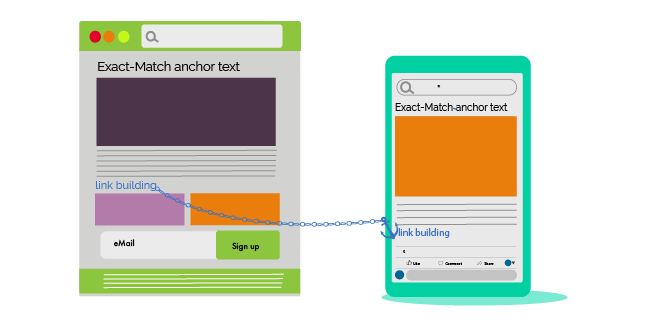
For example, if you link to a page about link building using the keyword ‘link building’. Then that would count as an exact-match.
It doesn’t matter if you have a short, medium, or long-tailed keyword made up of a few words. As long as it is an exact match, it will count.
2. Partial-Match (or Phrase Match)
Anchor text which is a ‘partial-match’ includes a variation of the keyword on the linked-to page.
For example, you may use the anchor text ‘best link building strategies for small businesses’ when you link to a page about link building.
These types of anchor text are one of the best ways to incorporate a keyword into your anchor text. This is because they don’t appear spammy. You can still mention the keyword, but you also include additional words to soften the match. Therefore, the term appears more natural to Google.
3. Brand Name
Every brand should rank in first place for their own brand name. And you can achieve this by using your actual brand name as the anchor text.
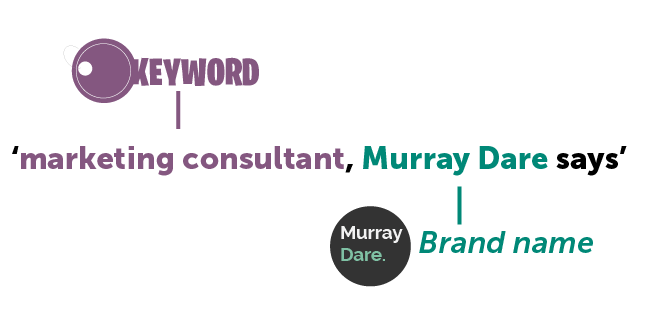
For example, for my site, I would anchor ‘Murray Dare’ and link to one of my web pages.
If your content features on external websites, then this can be great for brand recognition. Especially if it’s on a website which receives a lot of views.
But, your brand name can also associate you with the keywords which are relevant to your industry. If you anchor your brand name within a sentence which contains a relevant keyword (also known as a latent semantic index keyword), you also indicate relevance between your brand and that search term.
In this case, the anchor text; ‘marketing consultant, Murray Dare says’ would allow Google to understand two things. First, the name of my brand and second, the type of industry I operate in.
4. Keyword Branded
A keyword branded piece of anchor text includes your brand name and a keyword. They can help you optimise for a particular keyword without appearing spammy to the search engine and build brand recognition at the same time.
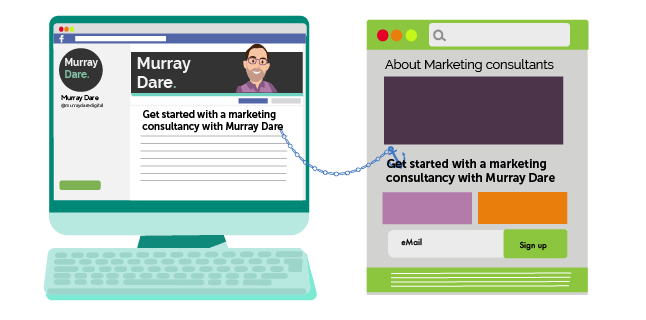
For example, ‘Get started with a marketing consultancy with Murray Dare’ includes your target keyword ‘marketing consultancy.’ However, it also includes your brand name.
This type of anchor text is fairly straightforward. In fact, it’s most common usage is by external sites. Especially when they refer to your product or service.
5. Naked Link
Anchor text which is the same as the URL is known as a ‘naked link.’
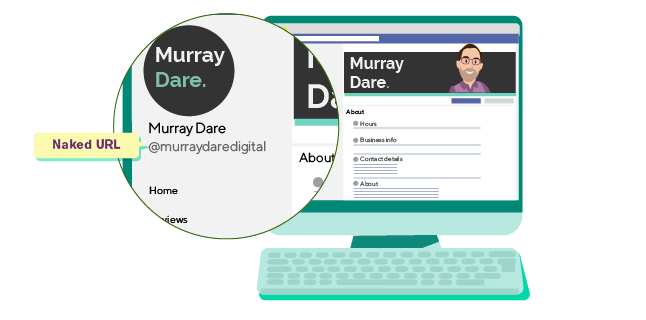
For example; ‘www.murraydare.co.uk’
These are infrequently used by most website owners. Mostly because, as most content creators agree, text looks more visually appealing when the link is hyperlinked within a sentence that naturally flows. However, they are still common online. And you will often see them on websites like local directory listings or on social media profiles.
6. Generic
A generic piece of anchor text can be any kind of word or phrase that isn’t keyword or brand related. Instead, the reader must rely on copy that surrounds it for contextual clues about what the link will direct them to.
Usually, these are types of call-to-actions, such as ‘click here,’ or ‘find out more.’ They offer no keyword relevance. But search engines can still make associations between the page linking to the external site. To do this, they contextualise the other words which are on the page.
7. Images
Lots of websites hyperlink images. Especially if they are attributing credit to the original source.
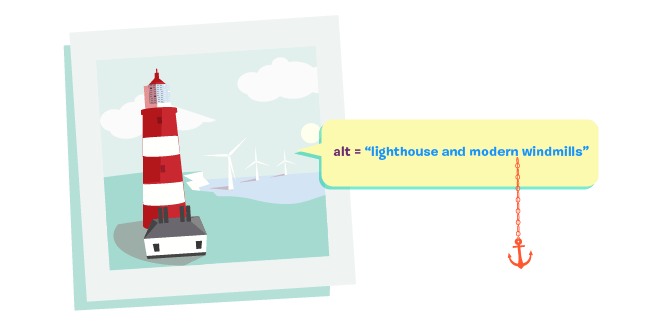
In these scenarios, the alt text often becomes the anchor text. With Google making connections between this and the link from the image itself. Therefore, it’s important you optimise all your images with alt text, to make sure the correct associations are made.
Top tip: Use Anchor Text Naturally
As we’ve discussed, as long as you use a variation of the different types of anchor text across your website, then you have no fear of penalisation.
To ensure you achieve this, you should strive to use anchor text naturally within your pages. And include links within your content where you think it seems most appropriate for the readers who engage with your content.
Remember, search engines focus on the delivery of best user experience. If you know you are using anchor text in a way that offers value to your audience, then you know you’re using it correctly.
Summary
Anchor text plays an important role in your website’s SEO rankings. When it comes to Google, the words you use to anchor your links to a page allow it to understand what the linked page is about. As well as separate the ‘legitimate’ from the ‘spam’ sites.
Furthermore, beyond Google, your anchor text is also hugely important for your readers. Because it allows them to understand what they can expect if they click on your links.
In this way, you need to pay careful attention when you choose what types of anchor text to use. For example, make sure they are as clear and effective as possible for the reader. However, this also means you should use a diverse range of anchor texts. And you definitely shouldn’t keyword stuff.
Everything search engines do is to improve the user experience. Focus your energy and only include relevant links within your content, rather than trying to rank for particular search terms. That way, you will put yourself in the best place possible to use anchor text correctly and avoid penalisation.
Developing a Long-Term Content Marketing & SEO Strategy With a Marketing Consultancy
Of course it’s great to understand how to use anchor text within your website. But it only has an impact if it’s part of a well-planned content strategy. One that’s designed to give you success in the long-term.
Many small businesses and start-ups have never had experience in the world of content marketing and SEO. As a result, they often turn to a marketing consultancy for help.
We can work with you and your team directly, to help you create and implement an actionable SEO strategy. One which incorporates the use of backlinks and well-distributed anchor text to help improve your rankings, increase your site traffic and optimise your conversion rate.
For more details on the services we offer and how we can help you online, please get in contact. I’d love to learn more about your company and would be happy to have an obligation-free chat about our work.
